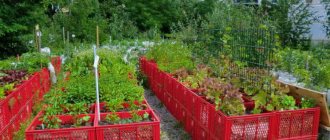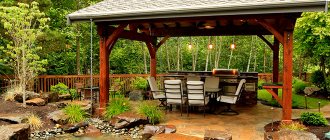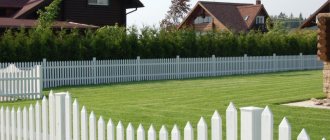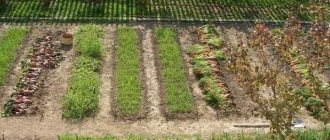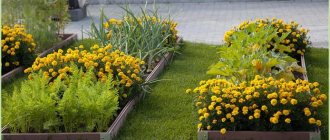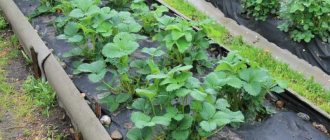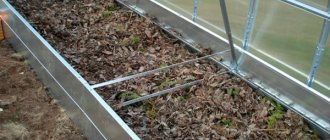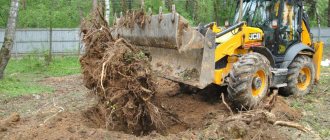Mittlider method beds are an effective and less labor-intensive method of vegetable growing than traditional tillage, allowing you to grow high-quality crops in large quantities even on poor soils and in climatic conditions that are far from ideal.
The classic process of growing in vegetable gardens consists of autumn plowing, spring harrowing, 3-5 weedings and loosening per season, and fire cleaning. It has been proven that this method of cultivation disrupts the structure of the soil, making it poorer, leveling hygroscopicity and killing microorganisms. Dr. Jacob R. Mittlider, a world-renowned international agricultural consultant, developed this method of gardening more than 50 years ago to show the public how to grow food in small spaces, in harsh climates and poor soil conditions. The American doctor experimentally proved the effectiveness of his approach, which is much less labor-intensive and cost-effective. It is already used in dozens of countries around the world. Let's get acquainted with this method.
The more effective the Mittlider method from classical gardening
| Classic vegetable garden | Beds using the Mittlider method | |
| All in all: | It is difficult to obtain high yields. Every gardening task requires so much skill and understanding that few beginners can produce a good harvest. | With the proper knowledge, even beginners can grow garden crops and get high yields |
| Gardener: | To grow a vegetable garden, a gardener must have skills, experience, good soil, and knowledge of botany | With the proper knowledge, anyone can grow any vegetable in any soil, in any climate, with minimal water and effort per unit of harvest. |
| The soil: | A good vegetable garden starts with good soil. Soil richness is the most important factor in gardening success. | Although good soils are encouraged, a productive vegetable garden can be built in any soil. If necessary, you can prepare individual soil mixtures for the beds. |
| Arrangement: | The classic arrangement of wide beds, arranged in rows, with narrow aisles. | Forming a vegetable garden using narrow beds or boxes for growing vegetables, the distances between rows and aisles are wide, based on human ergonomics. |
| Distance between plants : | Classic plant spacing to allow plants to grow horizontally to seek light. | Narrower spacing between vegetable crops. The emphasis is on vertical growth of plants for good lighting and saving space. |
| Seeds: | Planted in spring when the soil has warmed up. Since germination is often imperfect, expect some yield losses and weak plants. | You need to start with early planting in a simple greenhouse. Only strong and healthy plants should be replanted. |
| Plant nutrition : | Using manure, crop rotation and composting to improve soil fertility. Use of traditional fertilizers in their classic nitrogen-phosphorus-potassium combinations. To reduce costs, apply as little expensive fertilizer as possible. | Precise application of properly balanced factory-made fertilizers is more effective. Most purchased fertilizers need to be properly balanced and then supplemented with micronutrients for optimal effect. Fertilizers are applied before planting and several times after it. |
| Watering: | Using watering cans, sprinklers and watering with natural precipitation. Distributing water evenly is quite difficult. | To save water, only the roots are watered using drip irrigation. If you level the soil, water and nutrients will be distributed easily and evenly. |
| Weeding: | Since weeds are ubiquitous, labor-intensive weeding is a necessary evil that cannot be avoided. | Thanks to raised beds, weed control is much easier. Plant vegetables immediately after preparing the soil. Destroy weeds as they appear. |
| Trimming: | As a rule, vegetables are never pruned. Allow tall garden crops such as tomatoes, zucchini and melons to grow horizontally, often occupying 15-10 square meters. | Careful pruning of some plants can significantly increase yield. Increase yields by removing excess foliage that does not contribute to the growth of the plant and its fruits. Use rods, ropes and T-frames to grow plants upward rather than outward, saving space. |
| Harvesting: | Harvest once a year. At the end of the season, the land is plowed. | Two to three harvests per year. Increasing yields through the use of seedlings, balanced fertilizers, precise watering and pruning. |
| Crop rotation: | Every harvest depletes the land. It is necessary to regularly change the place where vegetables are planted to replenish the soil's fertility. | Crop rotation is good, but the land cannot be rejuvenated in one winter. Using balanced fertilizers is a more effective way to replenish soil fertility. |
Principles of intensive farming
The Mittlider Method is based on the idea that anyone can grow a productive vegetable garden in almost any environment. Dr. Mittlider has spent years of research to determine the best way to plant, water and feed vegetables and garden plants. The end result is a vegetable garden formed in long, narrow beds or growing boxes that are fed with a special soil mixture.
This way, people can achieve high yields even in rocky, sandy, poor quality soil or small areas such as tiny garden plots.
The book on the Mittlider method “Grow-Bed Gardening” talks about the main paradigms of technology. They are as follows:
- correct geometry of the beds;
- a special scheme for planting garden crops;
- balanced nutrition with mineral fertilizers;
- full lighting;
- frequent root watering.
How and with what to properly fertilize the beds
A constant flow of macro- and microelements to the rhizome is ensured by two types of soil mixtures. The first is pre-sowing, consists of dolomite flour (5 kg) and boric acid or borax (40 g). Consumption depends on soil composition:
- on the lungs – 100 g per m;
- on heavy soils (loamy-clayey, acidic peat) - 200 g each.
The same mixture can be used for constant feeding, but it is fundamentally important to add a second one. One of the ways to prepare it: a combination of potassium sulfates and magnesium urea and nitrophoska (1: 1: 1: 0.6). It is also recommended to add boric and molybdic acids, 15 g each, or borax (25 g) or sodium ammonium molybdate (20 g).
The second mixture is applied permanently throughout the season at least once every 10 days. in an amount of 25-40 (for unfavorable soils and for optimal conditions) exclusively in dry form. This makes up for the need for constant watering - for the supply of nutritional elements to the rhizome and their absorption by the plants. But watering is not done by sprinkling, which, according to the rules of agriculture according to Mitlider, is considered one of the main causes of powdery mildew and yellowing of sprouts, but only at the root. So, the author claims, the consumption will be less.
Organics during the growing season and nitrogen-containing mixtures are contraindicated due to a possible excess of nutrients, which is detrimental to vegetables.
How to water beds according to Mittlider
The water should be non-chlorinated and soft, settled and heated in the sun. Daily watering is required at high temperatures. Until mid-August, the beds are irrigated in the evening, and then only early in the morning.
Loosening of the beds is never carried out, which cannot but please rural residents who are familiar with classical methods of cultivating vegetable gardens. You just need to make sure that there is no crust from drying out. But with the correct planting geometry and compliance with watering requirements, this does not happen even during hot summer periods.
Russian fertilizers versus Midlander chemicals
Many Russian gardeners use the narrow bed method, but often refuse mineral fertilizers (mixtures 1 and 2). This is due to the fact that the active use of fertilizers without appropriate knowledge in crop production does not always give the desired result. Dr. Mittleider's method in the Russian version often involves the use of humus, compost, green infusion of herbs, a solution with manure, ash, etc. What are the advantages of natural fertilizers, what are the disadvantages associated with the use of Mittleider's mixtures?
- The use of mineral fertilizers affects the taste of the fruit; many gardeners do not like it. And by replacing mineral fertilizers with natural organic fertilizers, you can get an environmentally friendly harvest.
- It is better not to feed plants with additional fertilizers than to overfeed them, since excess nitrates will harm their health.
- In order for the minerals to dissolve and be absorbed, abundant watering and sunny weather are required, which is not always compatible with the weather conditions of some regions. In addition, it is important to know that abundant watering on some days is beneficial, and on others it is harmful for plants, and the periods of their development must be taken into account. Each crop has its own method of watering: for some - sprinkling, and for others in dry weather - at the root.
- If there is manure humus (not fresh manure, but thoroughly rotted manure compost), you can abandon the Mitlider method of fertilizing.
How to form beds using the Mittlider method
When planning a vegetable garden using the Mittleider method, you must first decide whether you want to use regular beds or raised beds to grow vegetables.
2 types of beds according to the Mittlider method
Regular beds
According to the Mittlider method, ordinary beds for planting vegetables should be narrow - 0.45 m, and the intervals between rows large - 1 m 5 cm. Wide passages are never cultivated (weeds are pulled out exclusively). They provide maximum light flow to each plant. The height of the side is from 10 to 20 cm, but the level of the bed and row spacing should be the same. The sides guarantee the safety of fertilizers in the beds and the circulation of water.
The length of the beds depends on the individual characteristics of the site and may well be up to 9 m.
Tomatoes using the Mittlider method are planted densely in these stationary beds. They will be the same in size and soil composition as the beds for cucumbers, with the only difference being that different rows of planting are assumed - in 1 or 2 rows.
The site is carefully leveled, the cardinal directions are determined. The beds are necessarily directed from north to south (meridional direction).
These beds are not demanding regarding the composition of the soil, but the soil must be loose and non-caking (preferably light), naturally aerated, weed-free, hygroscopic and moisture-permeable.
The method assumes the possibility of constructing beds in boxes or with earthen sides. The first ones are built in poor soils, small areas and for growing early or expensive plant species. For example, such strawberries using the Mittlider method are much more productive than under normal conditions. But in large areas and farmland, beds with sides made of earth are naturally more popular.
Container gardening according to Mittlider
Raised beds or containers (boxes) for growing can be installed in areas with infertile soil. They are usually made from wooden materials, metal and are leveled in place. Growing boxes can be of any length, depending on the size of your garden. The containers are filled with pre-prepared soil mixture, a mixture of sawdust and sand, or other inert and organic combinations along with some fertilizer. This soil mixture is used year after year. It is never changed or thrown away.
Practical application of the system
If you decide to use this method, then you need to calculate everything correctly.
Site planning. We mark the land plot in advance. After marking, we determine the required number of seedlings, the necessary materials for forming ridges and how much fertilizer will be needed. In order for the plants to receive more light, the beds are placed from east to west, they are made into soil or on side. You should make your choice in advance. The sides complicate the organization of beds; they require additional material.
Watering. The traditional method of watering (sprinkling) will have to be eliminated. With this method, weeds grow and mold appears. It is better to use the root method or hand irrigation. Drip irrigation is the most suitable option, which saves water and labor costs.
Fertilizers. Fertilize the garden according to a schedule with special mixtures (recipes below). You should calculate in advance the required number of components for fertilizers so that there are no unexpected costs for their purchase.
When beds using the Mittlider method are not suitable for a vegetable garden
In certain areas, such solutions are prohibited from being used due to the lack of appropriate conditions. These determinants were:
- lowlands, areas with high groundwater levels, stagnant rainwater;
- proximity to industrial facilities and highways;
- shady areas;
- vegetable gardens without watering;
- pronounced microrelief (irregularities);
- the slope of the site is from south to north.
To get around the last ban, gardeners grow vegetables and potatoes using the Mitlider method in the latitudinal direction. This worsens the lighting, but stabilizes the flow of nutrients. It is also permissible to use shortened mini-beds with filling on one side and cutting off a clod of soil on the other to level the area. It is more convenient to do this in boxes or when framing the bed not just with a side of the earth, but with a wooden fence.
It is quite possible to use partially shaded areas, but the yield may decrease.
The best varieties of garlic for planting in winter
The size of future vegetables partly depends on the chosen variety for planting. If, when purchasing, you had to choose among new varieties or an unfamiliar name, it is recommended to pay attention to the region where it was grown and the conditions suitable for it. A good gardener will not conduct experiments and risk the harvest, but will choose the leaders of winter varieties.
- Podmoskovny. The name of the variety speaks for itself that it is in this region that it has proven itself well. This is a non-shooting variety with increased yield. One onion weighs on average about 55 grams. In terms of taste, it has good pungency.
- Komsomolets. This variety is one of the best. It has a large compacted head with 13 teeth. The culture is frost-resistant, the ripening period is 90 days. Refers to the type of ripening and mid-ripening plants.
- Sofievsky. It has a flattened, roundish head. The variety is widely used in cooking, frost-resistant with high yield. The largest head reaches 100 grams. The culture lasts a long time and is strong against fungal diseases .
- Lyubasha. The variety is in great demand among gardeners. Refers to ripening and mid-ripening. Not afraid of drought and severe frosts. It has a small head weighing about 20 grams. It is distinguished by the uniqueness of its composition and excessive sharpness.
After reading all the recommendations in this article, even a novice gardener will be able to understand how to plant garlic in the winter , and with the onset of spring days, boast of a rich harvest.
Lyubasha
Sofievsky
Komsomolets
Podmoskovny
Procedure for creating beds
Experienced followers of this solution identify several stages of work that all beginners go through:
- Layout. This is the selection and preparation of a site, thinking through design features based on the existing realities of the territory.
- General digging. This is carried out only once during the entire existence of the beds.
- Marking with ropes or boards (string with pegs, building level, tape measure required).
- Autumn construction of wooden beds . The thickness of the board is 25 mm, and the width is 20 cm. The cross-section of the timber is 5*5 cm. The wood is treated with an antiseptic. You will need galvanized corners, a hammer, a drill for self-tapping screws, a hacksaw, and self-tapping screws. When sealing land edges, it is advisable to form a bed immediately before planting, and not in advance.
- Filling with a lump of earth . An artificial substrate or light, loose soil is suitable.
The passages can be covered with a special film to eliminate weeds.
Planting vegetables and other crops
An individual approach for each crop with a rational planting scheme ensures maximum yield.
Photos of tomatoes planted in beds using the Mittlider method
But some general rules also exist:
- planting onions according to Mittlider, like most crops (carrots, beets, radishes, beans, garlic, corn), is carried out in two rows opposite with a distance of 0.1 m from the side;
- a checkerboard pattern (with a shift) is used for potatoes, cabbage and lettuce;
- single row is preferable for zucchini, peppers and tomatoes.
The spreading nature of the crops is also taken into account to optimize the distance in the rows (onions - 5 cm, potatoes - 35 cm).
Thus, you need to remember that seedlings and widely spreading crops are planted in one row, the rest - in 2.
The mash is prepared like this:
For 3 liters of non-chlorinated water, take 5 tbsp. spoons of sugar and a pinch of yeast. It ferments for 2-3 days, then it is added to the general tank. Before use, you need to store the mash in the refrigerator - it is valuable until it sours.
38:491
In a common tank, all the fresh water is infused for a week. Sometimes it should be stirred. When used, the infusion is diluted at least twice. (Yu.I. Slashchinin)
38:818 38:828
39:1333 39:1343
2. In a 200 liter barrel I put 2/3 of the barrel of weed grass. (you can add 2 shovels of ash). I fill it with water and cover it with film on top. Infuses for two weeks. When using infusion, I dilute it 1 to 10.
39:1724 39:9
40:514 40:524
3. I put fresh manure in a 200 liter barrel, 1/3 of the barrel. I fill it with water. Infuses for two weeks. When using infusion, I dilute it 1 to 10.
40:792 40:802
41:1307 41:1317
4. I put chicken manure in a 200 liter barrel, 1/3 of the barrel. I fill it with water.
Infuses for two weeks. When using infusion, I dilute it 1 to 20. 41:1587 41:9
42:514 42:524
43:1029 43:1039
44:1544 44:9
45:514
Greenhouses using the Mittlider method
The design provides special air circulation, which prevents condensation from collecting. The frame itself is made very durable. The use of screws instead of nails makes the structure collapsible.
Photo of a greenhouse and narrow beds using the Mitlider method
A stable microclimate is achieved by a large area of the structure. Additional mechanisms and devices (dispensers and ventilation hatches) are not used.
To save space, the beds themselves are somewhat narrowed - up to 0.3 m. The row spacing is, accordingly, up to 0.9 m. The length is usually half that of those placed in the fresh air.
As with open beds, greenhouses are as convenient as possible for the movement of people serving them, as well as for equipment and harvesting.
Conclusion.
The statement of supporters of narrow ridges and wide passages that such a site layout is universal and works well in all regions in any weather is not true. There are important nuances.
The design of narrow ridges and wide passages alone may not be effective without taking into account other factors.
How useful is the publication?
Click on a star to rate!
Average rating 4.5 / 5. Number of ratings: 48
No ratings yet. Be the first to rate.
User tips
Many people know that mulching is good for the soil. Thanks to it, the soil becomes lighter, looser, and weeds do not receive growth activation. Therefore, some craftsmen cover the area with mulch after constructing beds or harvesting in the fall. This also attracts natural rippers - worms, which improve the soil structure.
But otherwise, it is not advisable to change the technological map of the methodology in order to achieve maximum efficiency.
An improved vegetable garden will delight you with reduced labor costs, a beautiful appearance of the plot and a much larger harvest. The advantage of the method is that plants are less susceptible to pest attacks and diseases. But, if there is a Colorado potato beetle or other problems, it is permissible to use special substances.
It is not possible to call this method fully satisfying the principles of “clean” farming due to the active use of mineral rather than inorganic fertilizers. However, the indisputable fact is that it allows you to get the maximum yield in poor soils and unfavorable climates, without spending much physical effort and without requiring significant material investments.
Significant increase in yield
I often see in this question either misunderstanding or deceit.
In one of the articles we read: “creating narrow beds immediately increases productivity by 300%.” How does the author justify his words? One hundred square meters of garden yielded 300 kg of potatoes. Divided into narrow beds and wide paths. Under the beds you no longer have 100 square meters, but only 30. And the yield is the same (300 kg) from an area three times smaller. Logical?
For me, there is a complete lack of logic. An increase in yield per hundred square meters by 300 percent is if you received 300 kg of potatoes per hundred square meters, and began to receive 900 kg.
In the example given, the yield per hundred square meters was and remained unchanged. The author simply excluded the passages from the calculation of the area. But in reality they have not gone away - the size of the plot has remained the same as it was.
On one hundred square meters of area I have 50 square meters of beds and the same number of passages. I count the harvest not from the area of the bed, but from the area of the plot: bed area + aisle area.
For example, my maximum potato yield was 1200 kg per hundred square meters. But in terms of the area of the ridges - 2400 kg per hundred square meters. Incorrectly calculating the area occupied by a crop is an easy way to get a record harvest!
It is important to understand one simple idea here. The wider the passages, the fewer ridges there will be on your site. And the fewer plants you can plant. The smaller the potential harvest.
Can't provide adequate care? Reduce the area of the site. On the vacated area it will be possible to make a lawn, a recreation area, or sow green manure.
